The HR Manager's Role and Theories in Employee Motivation: An Essay
VerifiedAdded on 2022/12/30
|7
|1618
|99
Essay
AI Summary
This essay delves into the pivotal role of Human Resource (HR) managers in fostering employee motivation within organizations. It begins by defining motivation and its significance in achieving business objectives. The main body explores various motivation theories, including Maslow's Hierarchy of Needs and Herzberg's Two-Factor Theory, providing insights into how these theories can be applied to enhance employee engagement and performance. The essay also examines the practical application of these concepts through a case study of Tesco, a multinational company, highlighting the specific strategies it employs to motivate its employees. The conclusion summarizes the key findings and emphasizes the importance of effective HR practices in driving organizational success. The essay is supported by references to academic journals and books.
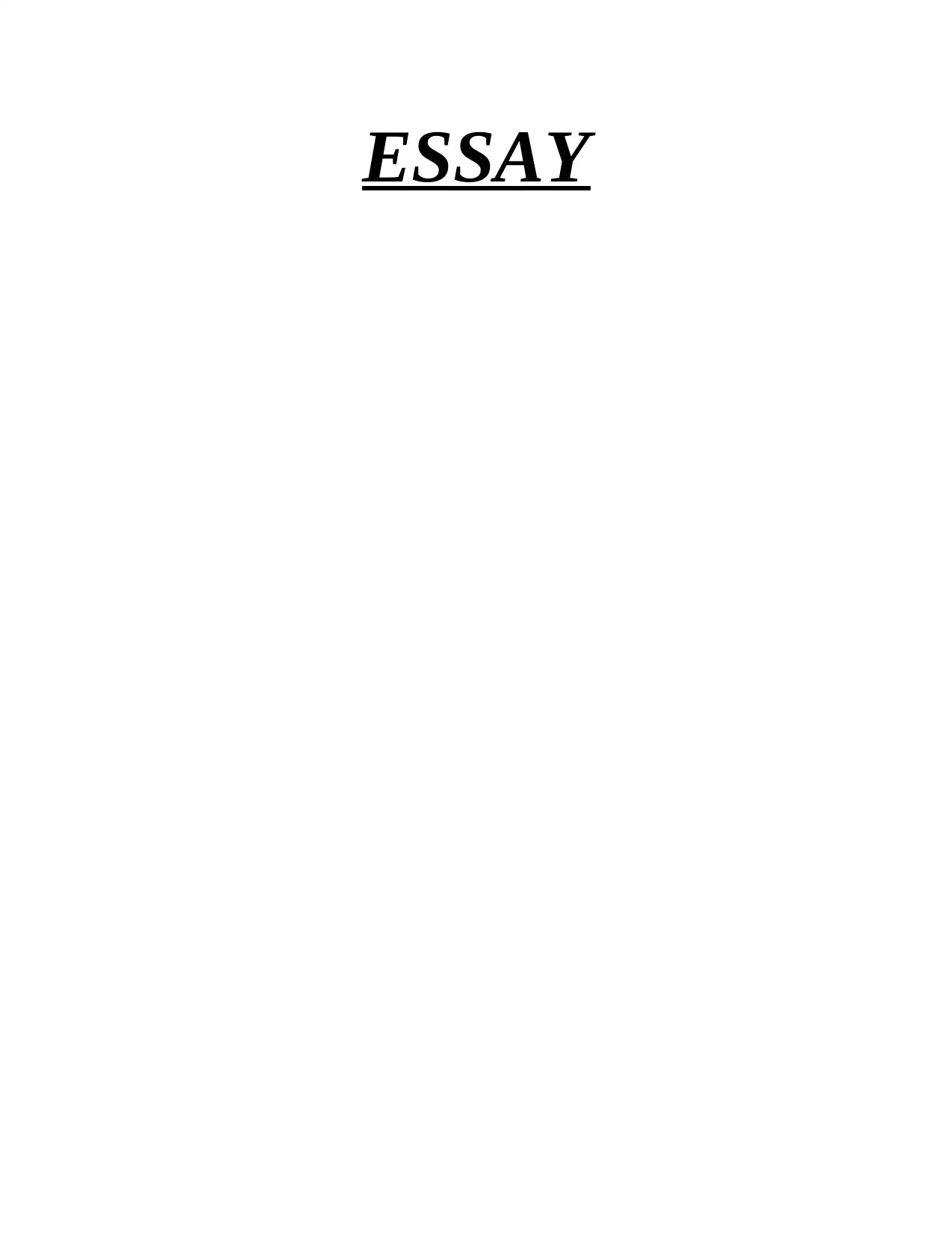
ESSAY
Paraphrase This Document
Need a fresh take? Get an instant paraphrase of this document with our AI Paraphraser
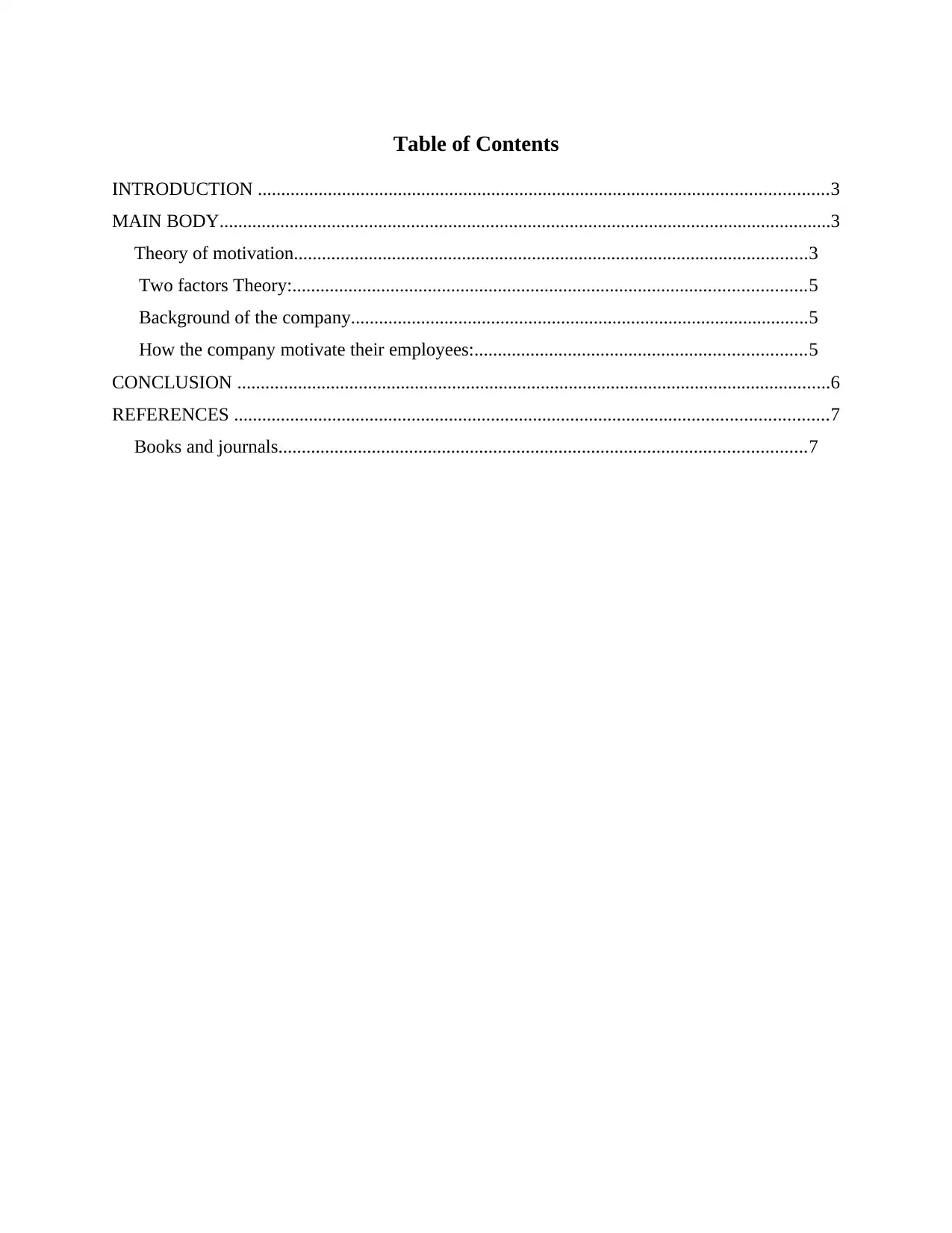
Table of Contents
INTRODUCTION ..........................................................................................................................3
MAIN BODY...................................................................................................................................3
Theory of motivation..............................................................................................................3
Two factors Theory:..............................................................................................................5
Background of the company..................................................................................................5
How the company motivate their employees:.......................................................................5
CONCLUSION ...............................................................................................................................6
REFERENCES ...............................................................................................................................7
Books and journals.................................................................................................................7
INTRODUCTION ..........................................................................................................................3
MAIN BODY...................................................................................................................................3
Theory of motivation..............................................................................................................3
Two factors Theory:..............................................................................................................5
Background of the company..................................................................................................5
How the company motivate their employees:.......................................................................5
CONCLUSION ...............................................................................................................................6
REFERENCES ...............................................................................................................................7
Books and journals.................................................................................................................7
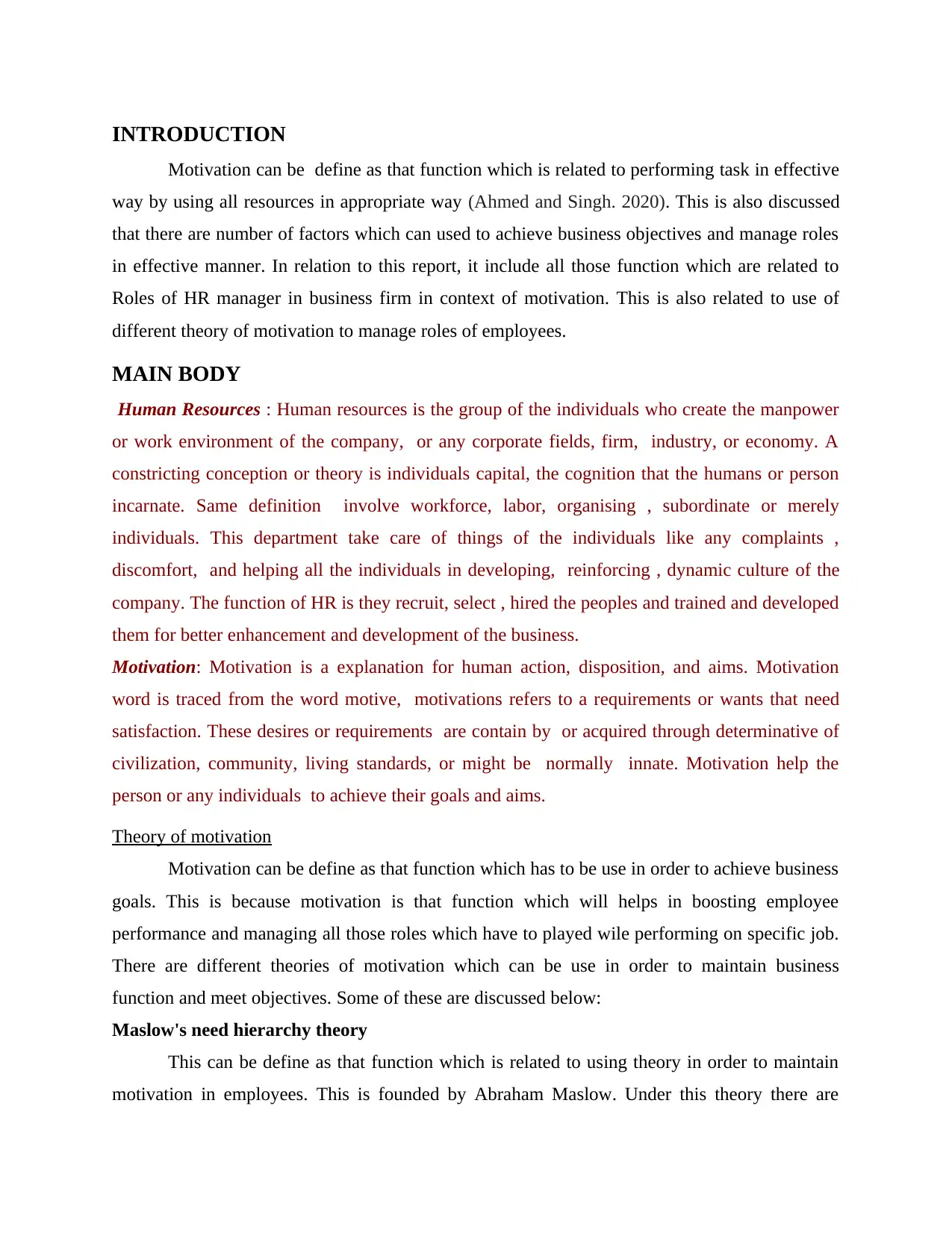
INTRODUCTION
Motivation can be define as that function which is related to performing task in effective
way by using all resources in appropriate way (Ahmed and Singh. 2020). This is also discussed
that there are number of factors which can used to achieve business objectives and manage roles
in effective manner. In relation to this report, it include all those function which are related to
Roles of HR manager in business firm in context of motivation. This is also related to use of
different theory of motivation to manage roles of employees.
MAIN BODY
Human Resources : Human resources is the group of the individuals who create the manpower
or work environment of the company, or any corporate fields, firm, industry, or economy. A
constricting conception or theory is individuals capital, the cognition that the humans or person
incarnate. Same definition involve workforce, labor, organising , subordinate or merely
individuals. This department take care of things of the individuals like any complaints ,
discomfort, and helping all the individuals in developing, reinforcing , dynamic culture of the
company. The function of HR is they recruit, select , hired the peoples and trained and developed
them for better enhancement and development of the business.
Motivation: Motivation is a explanation for human action, disposition, and aims. Motivation
word is traced from the word motive, motivations refers to a requirements or wants that need
satisfaction. These desires or requirements are contain by or acquired through determinative of
civilization, community, living standards, or might be normally innate. Motivation help the
person or any individuals to achieve their goals and aims.
Theory of motivation
Motivation can be define as that function which has to be use in order to achieve business
goals. This is because motivation is that function which will helps in boosting employee
performance and managing all those roles which have to played wile performing on specific job.
There are different theories of motivation which can be use in order to maintain business
function and meet objectives. Some of these are discussed below:
Maslow's need hierarchy theory
This can be define as that function which is related to using theory in order to maintain
motivation in employees. This is founded by Abraham Maslow. Under this theory there are
Motivation can be define as that function which is related to performing task in effective
way by using all resources in appropriate way (Ahmed and Singh. 2020). This is also discussed
that there are number of factors which can used to achieve business objectives and manage roles
in effective manner. In relation to this report, it include all those function which are related to
Roles of HR manager in business firm in context of motivation. This is also related to use of
different theory of motivation to manage roles of employees.
MAIN BODY
Human Resources : Human resources is the group of the individuals who create the manpower
or work environment of the company, or any corporate fields, firm, industry, or economy. A
constricting conception or theory is individuals capital, the cognition that the humans or person
incarnate. Same definition involve workforce, labor, organising , subordinate or merely
individuals. This department take care of things of the individuals like any complaints ,
discomfort, and helping all the individuals in developing, reinforcing , dynamic culture of the
company. The function of HR is they recruit, select , hired the peoples and trained and developed
them for better enhancement and development of the business.
Motivation: Motivation is a explanation for human action, disposition, and aims. Motivation
word is traced from the word motive, motivations refers to a requirements or wants that need
satisfaction. These desires or requirements are contain by or acquired through determinative of
civilization, community, living standards, or might be normally innate. Motivation help the
person or any individuals to achieve their goals and aims.
Theory of motivation
Motivation can be define as that function which has to be use in order to achieve business
goals. This is because motivation is that function which will helps in boosting employee
performance and managing all those roles which have to played wile performing on specific job.
There are different theories of motivation which can be use in order to maintain business
function and meet objectives. Some of these are discussed below:
Maslow's need hierarchy theory
This can be define as that function which is related to using theory in order to maintain
motivation in employees. This is founded by Abraham Maslow. Under this theory there are
⊘ This is a preview!⊘
Do you want full access?
Subscribe today to unlock all pages.

Trusted by 1+ million students worldwide
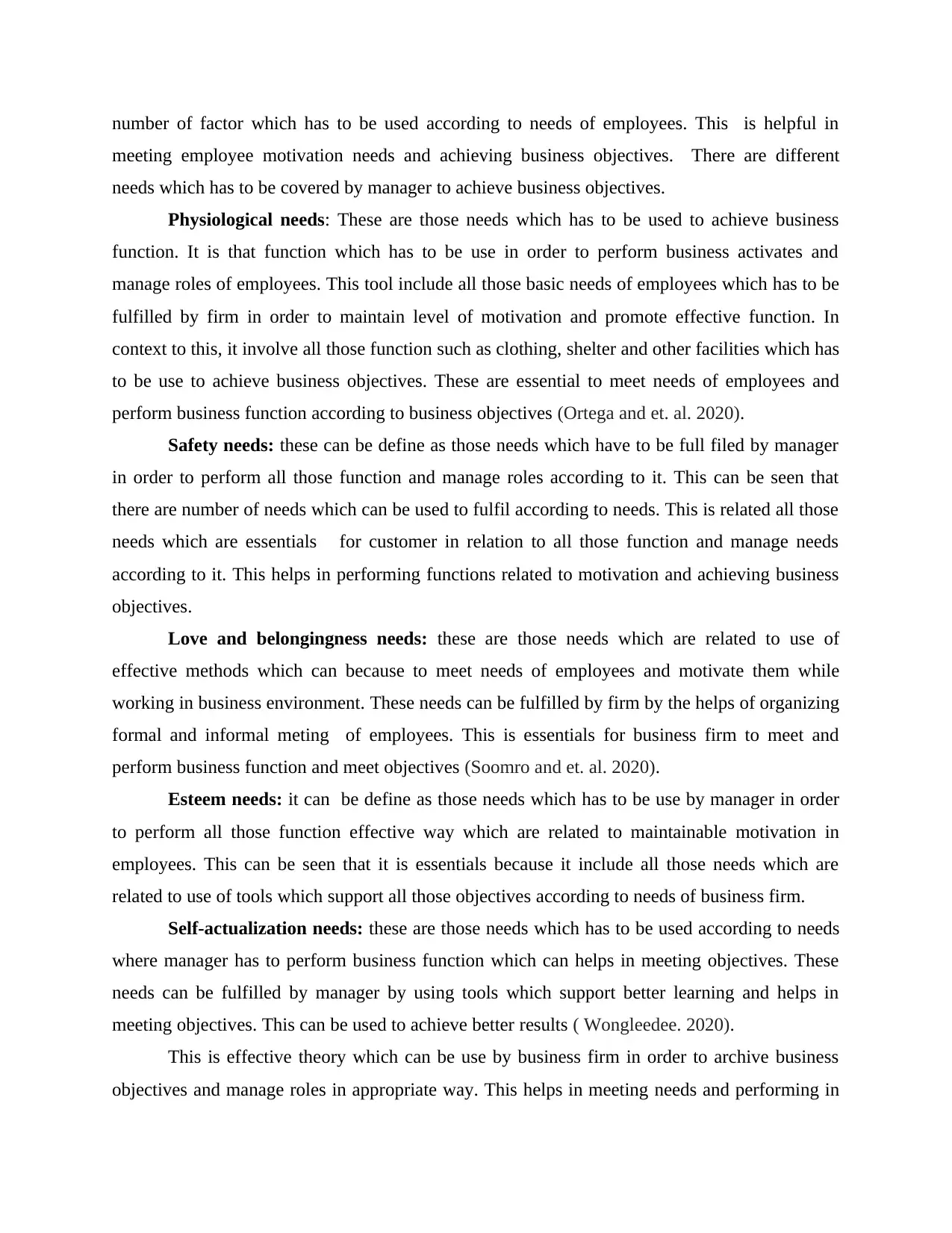
number of factor which has to be used according to needs of employees. This is helpful in
meeting employee motivation needs and achieving business objectives. There are different
needs which has to be covered by manager to achieve business objectives.
Physiological needs: These are those needs which has to be used to achieve business
function. It is that function which has to be use in order to perform business activates and
manage roles of employees. This tool include all those basic needs of employees which has to be
fulfilled by firm in order to maintain level of motivation and promote effective function. In
context to this, it involve all those function such as clothing, shelter and other facilities which has
to be use to achieve business objectives. These are essential to meet needs of employees and
perform business function according to business objectives (Ortega and et. al. 2020).
Safety needs: these can be define as those needs which have to be full filed by manager
in order to perform all those function and manage roles according to it. This can be seen that
there are number of needs which can be used to fulfil according to needs. This is related all those
needs which are essentials for customer in relation to all those function and manage needs
according to it. This helps in performing functions related to motivation and achieving business
objectives.
Love and belongingness needs: these are those needs which are related to use of
effective methods which can because to meet needs of employees and motivate them while
working in business environment. These needs can be fulfilled by firm by the helps of organizing
formal and informal meting of employees. This is essentials for business firm to meet and
perform business function and meet objectives (Soomro and et. al. 2020).
Esteem needs: it can be define as those needs which has to be use by manager in order
to perform all those function effective way which are related to maintainable motivation in
employees. This can be seen that it is essentials because it include all those needs which are
related to use of tools which support all those objectives according to needs of business firm.
Self-actualization needs: these are those needs which has to be used according to needs
where manager has to perform business function which can helps in meeting objectives. These
needs can be fulfilled by manager by using tools which support better learning and helps in
meeting objectives. This can be used to achieve better results ( Wongleedee. 2020).
This is effective theory which can be use by business firm in order to archive business
objectives and manage roles in appropriate way. This helps in meeting needs and performing in
meeting employee motivation needs and achieving business objectives. There are different
needs which has to be covered by manager to achieve business objectives.
Physiological needs: These are those needs which has to be used to achieve business
function. It is that function which has to be use in order to perform business activates and
manage roles of employees. This tool include all those basic needs of employees which has to be
fulfilled by firm in order to maintain level of motivation and promote effective function. In
context to this, it involve all those function such as clothing, shelter and other facilities which has
to be use to achieve business objectives. These are essential to meet needs of employees and
perform business function according to business objectives (Ortega and et. al. 2020).
Safety needs: these can be define as those needs which have to be full filed by manager
in order to perform all those function and manage roles according to it. This can be seen that
there are number of needs which can be used to fulfil according to needs. This is related all those
needs which are essentials for customer in relation to all those function and manage needs
according to it. This helps in performing functions related to motivation and achieving business
objectives.
Love and belongingness needs: these are those needs which are related to use of
effective methods which can because to meet needs of employees and motivate them while
working in business environment. These needs can be fulfilled by firm by the helps of organizing
formal and informal meting of employees. This is essentials for business firm to meet and
perform business function and meet objectives (Soomro and et. al. 2020).
Esteem needs: it can be define as those needs which has to be use by manager in order
to perform all those function effective way which are related to maintainable motivation in
employees. This can be seen that it is essentials because it include all those needs which are
related to use of tools which support all those objectives according to needs of business firm.
Self-actualization needs: these are those needs which has to be used according to needs
where manager has to perform business function which can helps in meeting objectives. These
needs can be fulfilled by manager by using tools which support better learning and helps in
meeting objectives. This can be used to achieve better results ( Wongleedee. 2020).
This is effective theory which can be use by business firm in order to archive business
objectives and manage roles in appropriate way. This helps in meeting needs and performing in
Paraphrase This Document
Need a fresh take? Get an instant paraphrase of this document with our AI Paraphraser
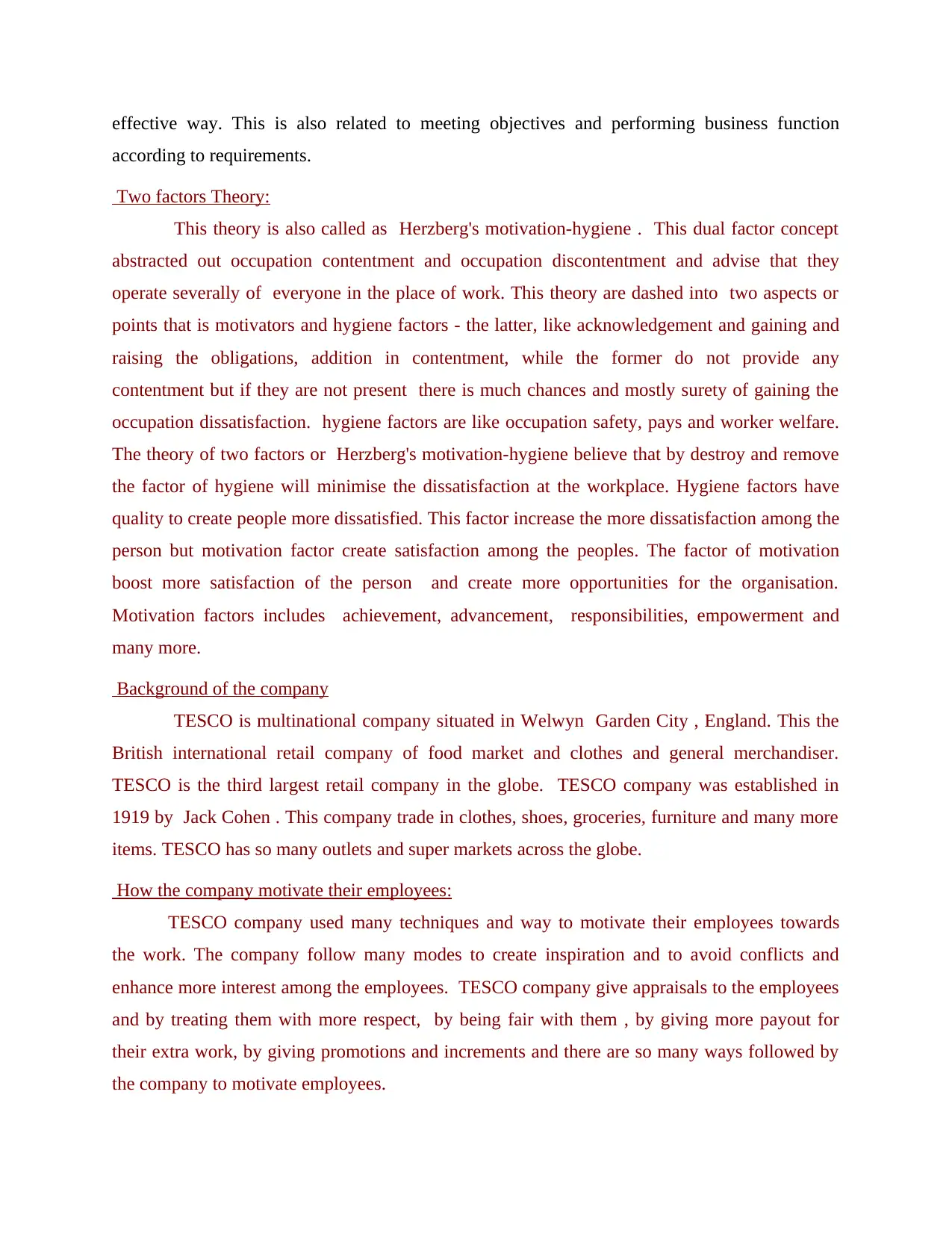
effective way. This is also related to meeting objectives and performing business function
according to requirements.
Two factors Theory:
This theory is also called as Herzberg's motivation-hygiene . This dual factor concept
abstracted out occupation contentment and occupation discontentment and advise that they
operate severally of everyone in the place of work. This theory are dashed into two aspects or
points that is motivators and hygiene factors - the latter, like acknowledgement and gaining and
raising the obligations, addition in contentment, while the former do not provide any
contentment but if they are not present there is much chances and mostly surety of gaining the
occupation dissatisfaction. hygiene factors are like occupation safety, pays and worker welfare.
The theory of two factors or Herzberg's motivation-hygiene believe that by destroy and remove
the factor of hygiene will minimise the dissatisfaction at the workplace. Hygiene factors have
quality to create people more dissatisfied. This factor increase the more dissatisfaction among the
person but motivation factor create satisfaction among the peoples. The factor of motivation
boost more satisfaction of the person and create more opportunities for the organisation.
Motivation factors includes achievement, advancement, responsibilities, empowerment and
many more.
Background of the company
TESCO is multinational company situated in Welwyn Garden City , England. This the
British international retail company of food market and clothes and general merchandiser.
TESCO is the third largest retail company in the globe. TESCO company was established in
1919 by Jack Cohen . This company trade in clothes, shoes, groceries, furniture and many more
items. TESCO has so many outlets and super markets across the globe.
How the company motivate their employees:
TESCO company used many techniques and way to motivate their employees towards
the work. The company follow many modes to create inspiration and to avoid conflicts and
enhance more interest among the employees. TESCO company give appraisals to the employees
and by treating them with more respect, by being fair with them , by giving more payout for
their extra work, by giving promotions and increments and there are so many ways followed by
the company to motivate employees.
according to requirements.
Two factors Theory:
This theory is also called as Herzberg's motivation-hygiene . This dual factor concept
abstracted out occupation contentment and occupation discontentment and advise that they
operate severally of everyone in the place of work. This theory are dashed into two aspects or
points that is motivators and hygiene factors - the latter, like acknowledgement and gaining and
raising the obligations, addition in contentment, while the former do not provide any
contentment but if they are not present there is much chances and mostly surety of gaining the
occupation dissatisfaction. hygiene factors are like occupation safety, pays and worker welfare.
The theory of two factors or Herzberg's motivation-hygiene believe that by destroy and remove
the factor of hygiene will minimise the dissatisfaction at the workplace. Hygiene factors have
quality to create people more dissatisfied. This factor increase the more dissatisfaction among the
person but motivation factor create satisfaction among the peoples. The factor of motivation
boost more satisfaction of the person and create more opportunities for the organisation.
Motivation factors includes achievement, advancement, responsibilities, empowerment and
many more.
Background of the company
TESCO is multinational company situated in Welwyn Garden City , England. This the
British international retail company of food market and clothes and general merchandiser.
TESCO is the third largest retail company in the globe. TESCO company was established in
1919 by Jack Cohen . This company trade in clothes, shoes, groceries, furniture and many more
items. TESCO has so many outlets and super markets across the globe.
How the company motivate their employees:
TESCO company used many techniques and way to motivate their employees towards
the work. The company follow many modes to create inspiration and to avoid conflicts and
enhance more interest among the employees. TESCO company give appraisals to the employees
and by treating them with more respect, by being fair with them , by giving more payout for
their extra work, by giving promotions and increments and there are so many ways followed by
the company to motivate employees.
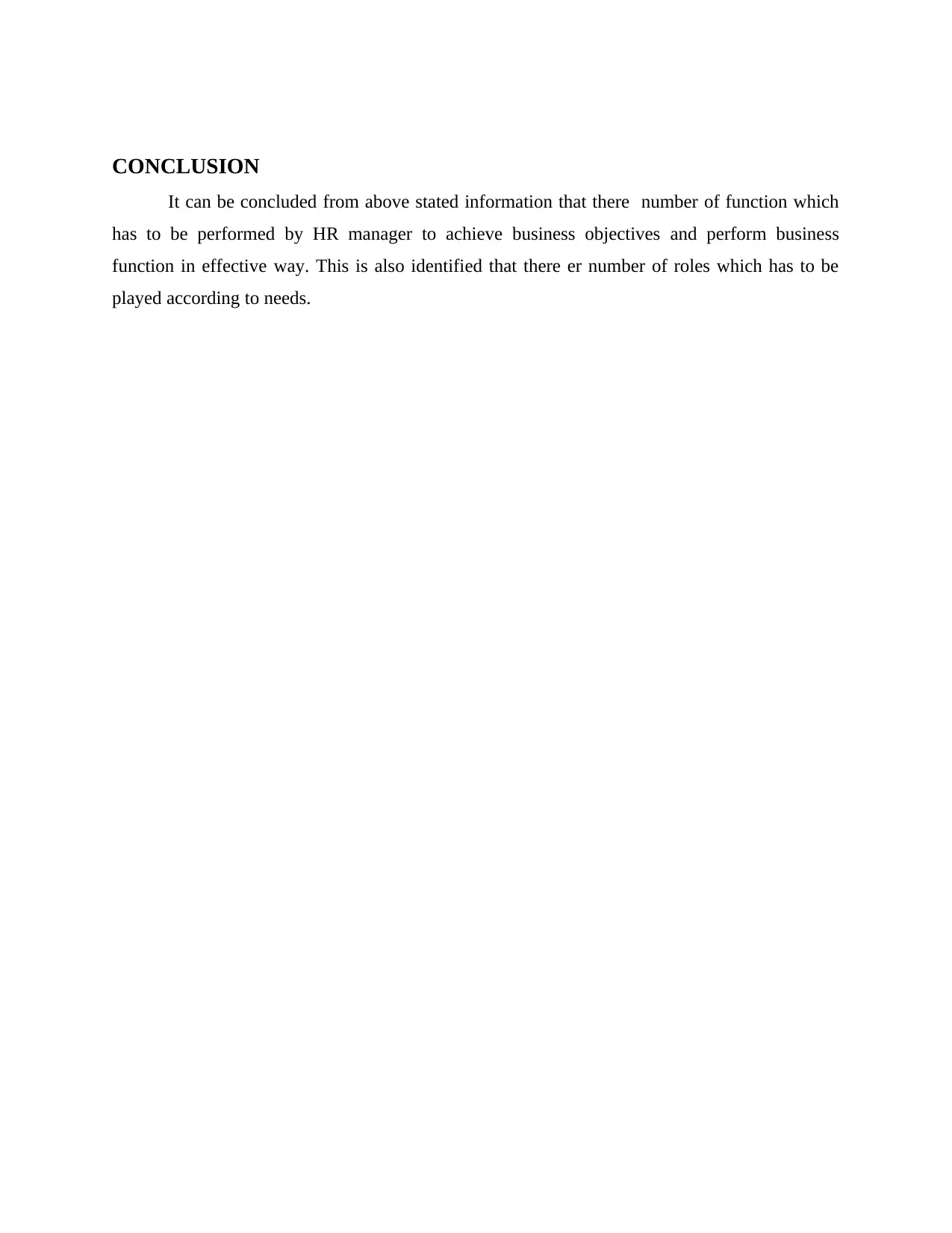
CONCLUSION
It can be concluded from above stated information that there number of function which
has to be performed by HR manager to achieve business objectives and perform business
function in effective way. This is also identified that there er number of roles which has to be
played according to needs.
It can be concluded from above stated information that there number of function which
has to be performed by HR manager to achieve business objectives and perform business
function in effective way. This is also identified that there er number of roles which has to be
played according to needs.
⊘ This is a preview!⊘
Do you want full access?
Subscribe today to unlock all pages.

Trusted by 1+ million students worldwide
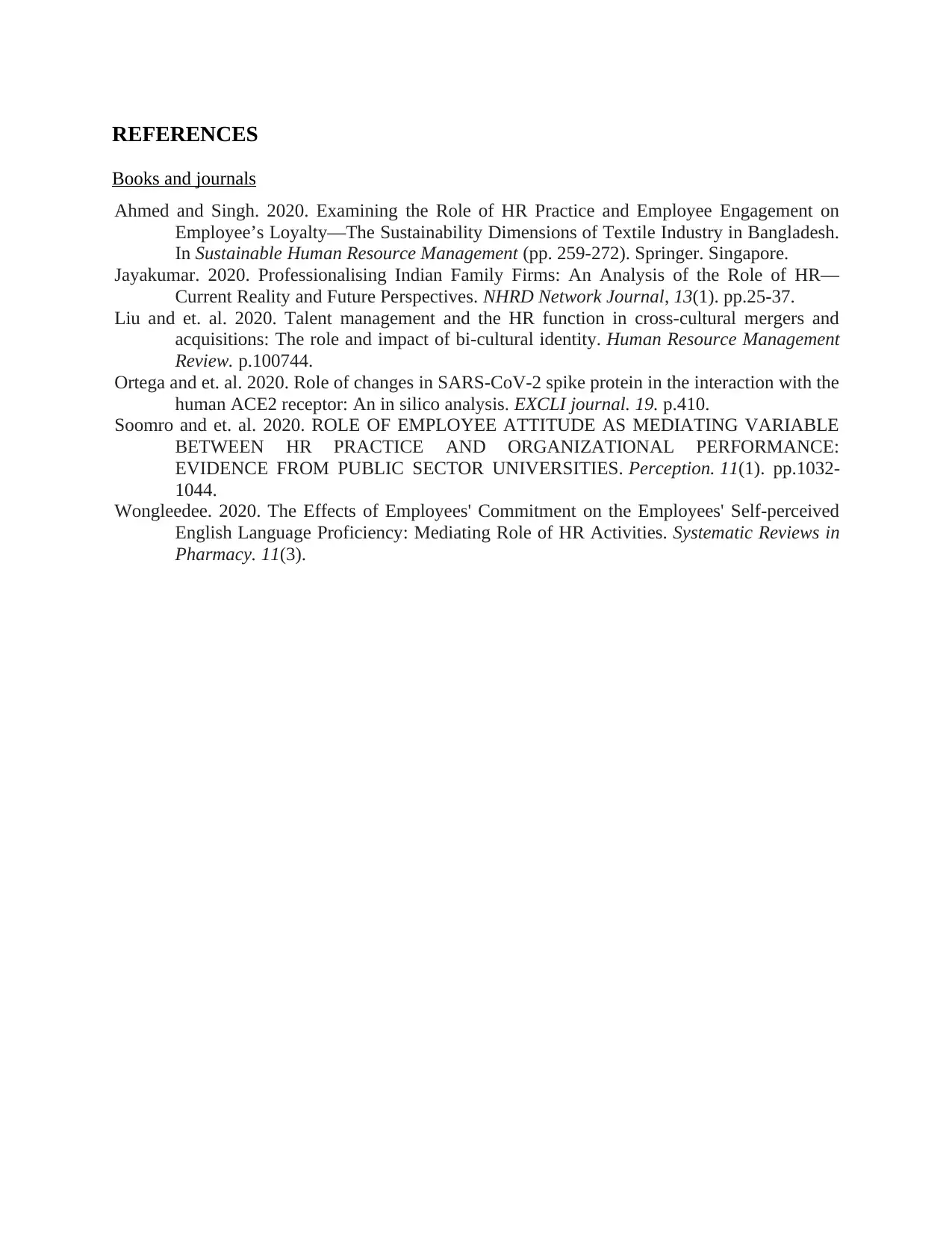
REFERENCES
Books and journals
Ahmed and Singh. 2020. Examining the Role of HR Practice and Employee Engagement on
Employee’s Loyalty—The Sustainability Dimensions of Textile Industry in Bangladesh.
In Sustainable Human Resource Management (pp. 259-272). Springer. Singapore.
Jayakumar. 2020. Professionalising Indian Family Firms: An Analysis of the Role of HR—
Current Reality and Future Perspectives. NHRD Network Journal, 13(1). pp.25-37.
Liu and et. al. 2020. Talent management and the HR function in cross-cultural mergers and
acquisitions: The role and impact of bi-cultural identity. Human Resource Management
Review. p.100744.
Ortega and et. al. 2020. Role of changes in SARS-CoV-2 spike protein in the interaction with the
human ACE2 receptor: An in silico analysis. EXCLI journal. 19. p.410.
Soomro and et. al. 2020. ROLE OF EMPLOYEE ATTITUDE AS MEDIATING VARIABLE
BETWEEN HR PRACTICE AND ORGANIZATIONAL PERFORMANCE:
EVIDENCE FROM PUBLIC SECTOR UNIVERSITIES. Perception. 11(1). pp.1032-
1044.
Wongleedee. 2020. The Effects of Employees' Commitment on the Employees' Self-perceived
English Language Proficiency: Mediating Role of HR Activities. Systematic Reviews in
Pharmacy. 11(3).
Books and journals
Ahmed and Singh. 2020. Examining the Role of HR Practice and Employee Engagement on
Employee’s Loyalty—The Sustainability Dimensions of Textile Industry in Bangladesh.
In Sustainable Human Resource Management (pp. 259-272). Springer. Singapore.
Jayakumar. 2020. Professionalising Indian Family Firms: An Analysis of the Role of HR—
Current Reality and Future Perspectives. NHRD Network Journal, 13(1). pp.25-37.
Liu and et. al. 2020. Talent management and the HR function in cross-cultural mergers and
acquisitions: The role and impact of bi-cultural identity. Human Resource Management
Review. p.100744.
Ortega and et. al. 2020. Role of changes in SARS-CoV-2 spike protein in the interaction with the
human ACE2 receptor: An in silico analysis. EXCLI journal. 19. p.410.
Soomro and et. al. 2020. ROLE OF EMPLOYEE ATTITUDE AS MEDIATING VARIABLE
BETWEEN HR PRACTICE AND ORGANIZATIONAL PERFORMANCE:
EVIDENCE FROM PUBLIC SECTOR UNIVERSITIES. Perception. 11(1). pp.1032-
1044.
Wongleedee. 2020. The Effects of Employees' Commitment on the Employees' Self-perceived
English Language Proficiency: Mediating Role of HR Activities. Systematic Reviews in
Pharmacy. 11(3).
1 out of 7
Related Documents
Your All-in-One AI-Powered Toolkit for Academic Success.
+13062052269
info@desklib.com
Available 24*7 on WhatsApp / Email
![[object Object]](/_next/static/media/star-bottom.7253800d.svg)
Unlock your academic potential
Copyright © 2020–2025 A2Z Services. All Rights Reserved. Developed and managed by ZUCOL.




